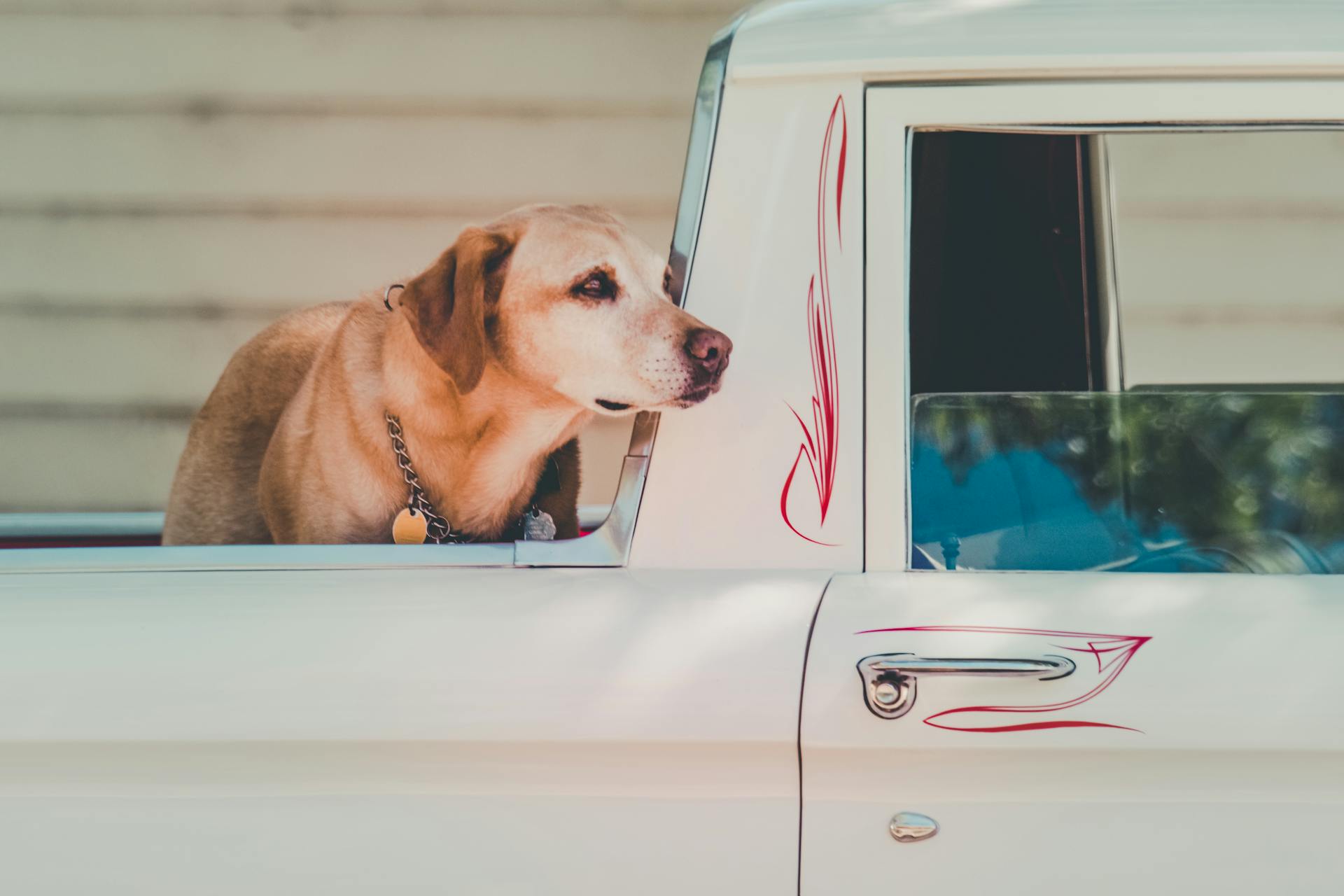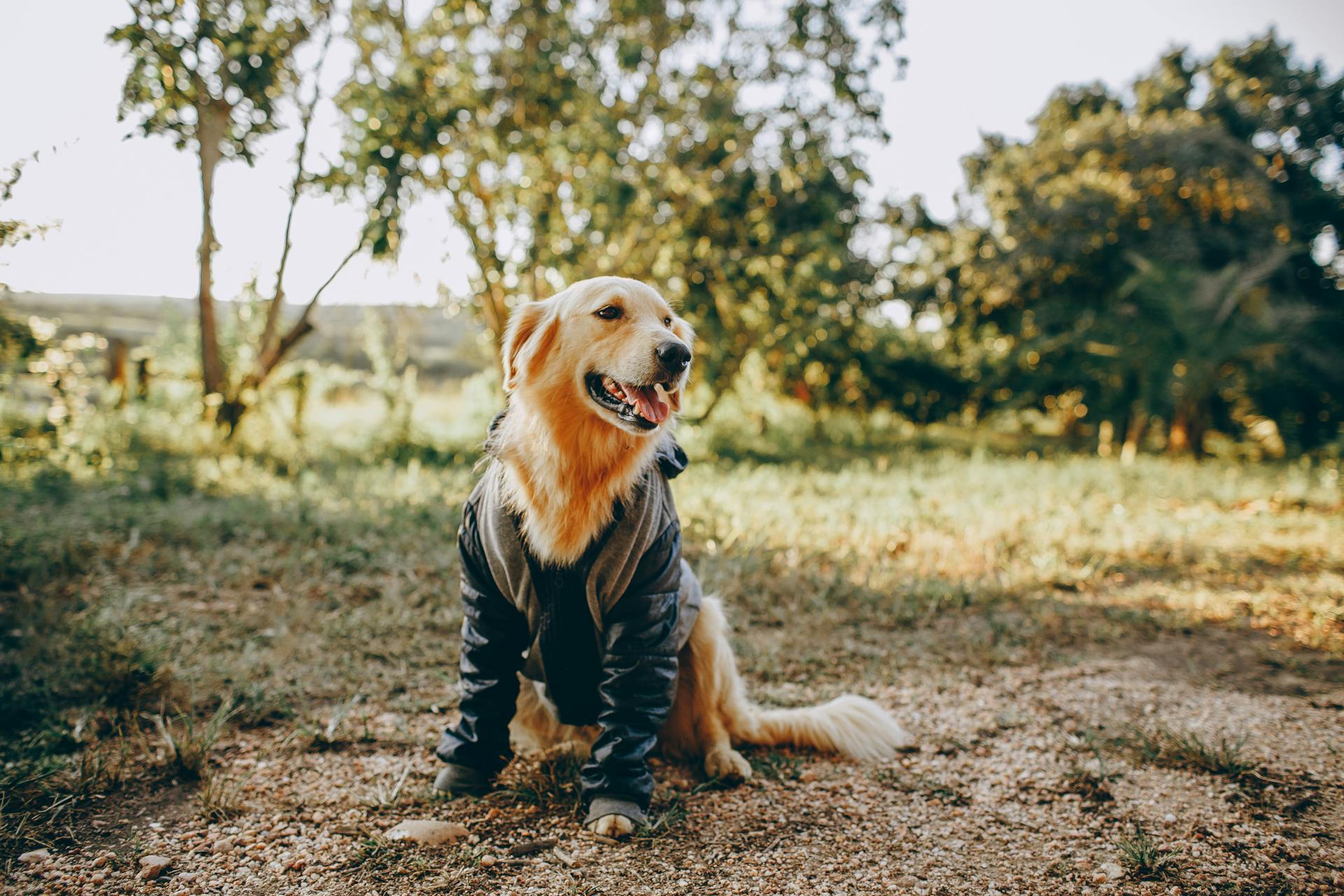
The Goldador, a mix of a Labrador Retriever and a Golden Retriever, is a popular breed for families and hunters alike. They typically weigh between 55-75 pounds.
Their intelligence and loyalty make them easy to train, and with proper socialization, they can thrive in a variety of living situations. With an average lifespan of 10-12 years, the Goldador is a long-term companion.
Their friendly nature and high energy levels mean they require regular exercise and mental stimulation to prevent boredom and destructive behavior. A daily walk and playtime should be a must for any Goldador owner.
What is a Goldador?
A Goldador is a crossbreed between a Labrador Retriever and a Golden Retriever. They're often considered a hybrid breed.
Goldadors typically inherit the friendly and gentle nature of their parent breeds. They're known to make great family pets.
Their coat can vary in color, but it's often a mix of the two parent breeds' characteristic colors.
Mixes
Labradors are a beloved breed, and their mixes are just as wonderful. One of the best things about Labrador mixes is that they can be healthier and longer-lived than purebreds.
Mixed breed canines, like Labradors, can be unpredictable due to mixed genetics. Owners can try out a doggie DNA and breed health test if they really want to learn more about their Labrador mix.
Labrador Retriever mixes can be found in many places, and some are very unexpected. Crossbreeds can make excellent family pets, but it's essential to choose a mix that's suitable for your lifestyle.
Labrakitas, for example, make excellent guard dogs, but they can be protective and distrustful of strangers. They're not suitable for families with young children and must be well-socialized as a puppy.
For your interest: Redbone Coonhound Pitbull Mix
Goldador
The Goldador is a crossbreed dog that's a mix of a Golden Retriever and an Labrador Retriever. They're often referred to as a "designer dog" because of their popularity as a hybrid breed.
Goldadors are known for their friendly and gentle nature, inheriting the calm and patient traits of the Labrador Retriever. This makes them an excellent choice for families with children.
They typically weigh between 55-75 pounds and stand between 20-24 inches tall at the shoulder. Their coat is usually a combination of the Golden Retriever's thick coat and the Labrador Retriever's short coat, requiring regular grooming to prevent matting.
Explore further: Yellow Golden Labrador
Physical Characteristics
Your Goldador puppy will look a lot like its littermates, and as an adult dog, it will be large, weighing about 75 lbs and standing 24 inches high.
They'll have a short coat, lightly feathered tail, floppy ears, broad chest, long muzzle, and lengthy legs. If your Goldador has working bred parents, it will have a narrower head.
Here are the possible colors your Goldador can come in, depending on its parents:
- Black Goldador
- Chocolate Goldador
- Yellow Goldador
- Dark golden Goldador
- Golden Goldador
- Light golden Goldador
Characteristics
Your Goldador will be a large dog, typically weighing around 75 lbs and standing about 24 inches high when fully grown.
They'll have a short coat and a lightly feathered tail, although the length of their coat can vary depending on their ancestry.
Floppy ears are a defining feature of the Goldador breed, and you can expect your dog to have a broad chest and a long muzzle.
Their legs will be lengthy, giving them a sleek and athletic appearance.
Goldadors with working-bred parents from American Labrador and Golden Retriever lines will have narrower heads, while those with show or English history behind them will have a blockier build.
A sociable Goldador won't do well with isolation, so make sure to provide them with plenty of attention and interaction.
Their excitability can be a challenge, especially if they inherit the Labrador's love of making new friends and meeting new people.
Curious to learn more? Check out: Dog That Looks like a Lab but Smaller
Mix Coat Types
Your Golden Retriever Lab mix puppy's coat type is likely to be a short double coat, similar to that of a Labrador Retriever. This means they'll have a soft undercoat and a water-resistant top coat.
If this caught your attention, see: Flat Coat Lab
The short double coat can be high maintenance, requiring regular grooming to prevent matting and tangling. Regular brushing can help keep their coat healthy and looking its best.
The coat color of your Golden Retriever Lab mix will depend on which parent they take after, with possible colors including black, chocolate, yellow, dark golden, golden, and light golden.
Here are some common coat colors you can expect to see:
- Black Goldador
- Chocolate Goldador
- Yellow Goldador
- Dark golden Goldador
- Golden Goldador
- Light golden Goldador
Shedding and Grooming
Your Goldador will shed a lot, especially during seasonal blowouts, so be prepared to brush them at least twice a week to catch loose hairs. A good pet hair vacuum is a must-have to keep your home clean.
Both parent breeds, Labradors and Golden Retrievers, have heavy shedding, so it's no surprise that their mix inherits this trait. Brushing regularly will help reduce loose hair and prevent hairballs.
You'll also need to clip your Goldador's nails weekly, either with pet clippers or a rotating claw sander. This will prevent overgrowth and discomfort.
Here's a quick checklist to keep in mind:
- Brush your Goldador at least twice a week
- Use a good pet hair vacuum regularly
- Clip their nails weekly
By following these simple grooming tips, you'll be able to keep your Goldador clean, comfortable, and looking their best.
Personality and Temperament
Goldadors are highly sociable dogs that don't like being left alone, so they can develop destructive habits like chewing due to boredom and anxiety.
Their friendly nature means they'll likely inherit the Labrador's excitability, which can lead to a love for new people and making instant friends.
You'll need to be prepared for mischief, as Goldadors have a strong prey drive and an amazing nose that can lead them to chase small creatures.
An enclosed backyard is a must to keep them safe and contained, and a good recall cue will help you keep them from getting into trouble.
Temperament
Your Goldador puppy will inherit a sociable personality from its Golden Retriever parent, making them not like isolation.
Goldadors are prone to chewing out of boredom and anxiety when left alone, so it's essential to provide them with plenty of attention and exercise.
They might inherit the Lab's excitability, which means they'll love new faces and making instant friends, but this can also lead to a boisterous personality.
Labs don't know a stranger, and this trait is often passed down to Goldadors, making them excellent social dogs.
An enclosed backyard is a must for a Goldador, as their strong desire to chase small creatures can lead to mischief.
Socialization
Socialization is a critical aspect of a Goldador's personality development. Early age socialization helps them get along with children and other pets.
Naturally, Goldadors are open to new experiences, but there are no guarantees when it comes to temperament in any breed. This is why training and socialization are essential.
You can start socialization and training with fun puppy training classes. These classes provide a great opportunity for your Goldador to interact with other dogs and people.
Training and Care
Training a half lab half golden requires patience and consistency, especially since they can be quite stubborn at times. With positive reinforcement methods, you can start training from day one and take advantage of their easygoing nature.
Goldadors, as they're sometimes called, have a long history of being service dogs, bomb detection dogs, hunting dogs, and therapy dogs. This makes them a great choice for those who are willing to put in the time to train.
Obedience classes are a great way to create well-mannered dogs and prevent unwanted behaviors like jumping up and running off, especially in large breeds.
Here are some key things to keep in mind when training your half lab half golden:
- They need a lot of exercise to stay happy and healthy.
- They're highly intelligent and can quickly learn behaviors, so be careful what you're rewarding.
- They love to play in water, so introduce them to it early on!
- Regular grooming is essential, especially during moulting season.
Training
Training your Goldador requires patience and consistency. With positive reinforcement methods, you can start training from day one, taking advantage of their easygoing nature.
Goldadors have a long history as service dogs, bomb detection dogs, hunting dogs, and therapy dogs, so they're naturally inclined to please. This makes them highly trainable if you put in the time.
Obedience classes are essential for creating well-mannered dogs, especially in large breeds like Goldadors. Avoiding jumping up and running off is crucial for their well-being and your safety.
Training a Labrador cross golden retriever can be challenging because it's a mix of two breeds that train differently. You never know what you'll get, as it depends on whether the individual dog is more like a Labrador or a golden retriever.
If you want a fun, playful dog with a cheeky personality, this breed might be for you. However, be prepared to stay one step ahead of them, as they can easily learn bad habits.
Golden retrievers tend to be more sensitive and cuddly, while Labradors are more motivated and keen to learn. A good mix of both breeds will give you a dog that loves you and working together.
Things to Consider Before Getting a Cross
Before getting a cross, it's essential to consider their exercise needs. These dogs require a lot of exercise, or they'll get restless.
Labrador cross golden retrievers are intelligent, but they can be stubborn at times. This doesn't mean they don't understand you; it just means they might not always want to do what you're asking.
They generally have a strong food drive, which makes them fun to train. You can quickly teach them behaviors, so be careful what you're rewarding.
Curious to learn more? Check out: Scoodle Dog
Introducing them to water is a must, as they love to splash about. This will help them enjoy water-based activities and prevent any potential issues.
To keep their coat healthy, they need regular grooming. Brushing them two or three times a week is a good starting point, and proper grooming is crucial during moulting season.
Health and Longevity
Labrador Golden Retriever mixes are generally a healthy breed, but like all breeds, they can be prone to certain health issues. Both parent breeds are susceptible to hereditary health conditions, joint problems, and common health issues.
To minimize the risk of hereditary health issues, it's essential to work with a reputable breeder who has followed the recommended testing for both parent breeds. This includes testing for Hereditary Nasal Parakeratosis (HNKP), Centronuclear Myopathy (CN), Hip and Elbow Evaluation, Progressive Retinal Atrophy (PRA), Exercise Induced Collapse (EIC), and Hereditary Cataracts (HC).
A Goldador's life expectancy is around 10 to 12 years, similar to their parent breeds. However, chocolate Labradors and potentially chocolate Goldadors may have a slightly shorter lifespan and higher risk of ear and skin infections.
Health
As you consider bringing a Goldador into your family, it's essential to understand the potential health risks associated with this breed. Goldadors are prone to joint problems like elbow and hip dysplasia, which can be a real challenge for their owners.
To minimize the likelihood of hereditary health issues, make sure your breeder has followed the recommended testing for the Labrador Retriever breed, which includes hereditary nasal parakeratosis, centronuclear myopathy, and hip and elbow evaluation.
Progressive retinal atrophy (PRA) is a common health issue in both Labradors and Golden Retrievers, and it's crucial to ensure your breeder has screened for this condition in both parent breeds.
A varied diet and small, frequent meals can help decrease the risk of bloat in Goldadors, which is a serious health issue that can't be predicted.
Some recommended testing for Golden Retrievers includes a cardiac exam, including an echocardiogram, and ophthalmological exams to check for hereditary cataracts and other eye problems.
Here are some common health issues that can affect Goldadors:
- Elbow and hip dysplasia
- Bloat
- Ear problems
- Hereditary cataracts
- Progressive retinal atrophy (PRA)
It's essential to work with a reputable breeder who has proof of testing for all breed-recommended tests for both parents to increase the likelihood of a healthy puppy.
How Long Do They Live?
Goldadors typically live between 10 to 12 years, which is comparable to their parent breeds. This lifespan can vary depending on individual factors, but overall, they have a relatively long life expectancy.
Chocolate Labradors, which are often part of the Goldador mix, have a 10% shorter lifespan than other Labs. This is due to their higher rate of ear and skin infections.
Intriguing read: Golden Retriever Lab Mix Lifespan
Sources
Featured Images: pexels.com


